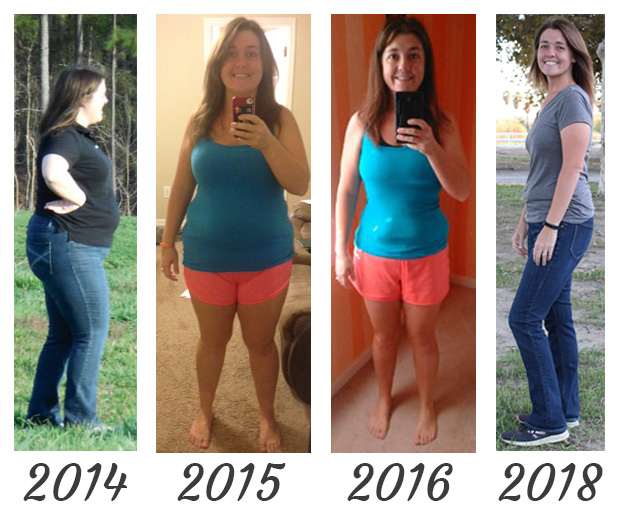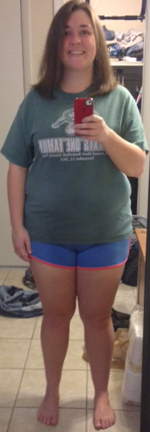
Dirty fasting gets a bad rap in the intermittent fasting community, but I found it was the path to sustainable weight loss for me. I lost 80 pounds and have maintained in my goal range for over 5 years, all because I changed the way I practiced intermittent fasting to make it more enjoyable. Dirty fasting has been the key to both losing and keeping off the weight.

Why I Chose Dirty Fasting Over Clean
In 2015, I weighed 222 pounds. I was 5’ 6” and, according to the Body Mass Index (BMI), I was obese. I had lost weight successfully countless times before. My problem was that I could never keep it off, and I felt humiliated every time I gained it back. I joined a gym and discovered that I liked to lift heavy weights. I stumbled across Martin Berkhan’s Leangains blog, and that’s where I first learned about intermittent fasting. Martin unashamedly admitted he loved cheesecake, so I was open to hearing what he had to say about weight loss. According to him, a person could lose weight if they did not eat during a good chunk of the day. I figured it was worth a shot.
My Clean Fasting Experience
At first I tried being strict with my fasting window, also known as clean fasting. With this type of fast, you don’t consume any calories or even artificial sweeteners in your fasting window. Each morning I practiced intermittent fasting, I would dutifully hold off on having coffee until my eating window opened up.
But as my fasting window grew longer, delaying my morning coffee wore me down. I could do it. I just didn’t want to do it. It was kind of miserable, waking up, wanting coffee, and not getting any.
The ritual of starting my day with my coffee was something I cherished, and intermittent fasting had now taken that away from me. Resentment built inside me. My intuition told me I would not stick with intermittent fasting for much longer if I didn’t figure this piece of the puzzle out.
I searched on the Leangains blog for mentions of coffee, hoping that somehow, by some miracle, I could have coffee in my fasting window. In one post, he advised people who were obsessing over the fasting window to not worry about a splash of milk in their coffee. To focus on those things was to lose sight of the big picture.
The big picture of intermittent fasting is that you’re not eating for a sizeable chunk of your day. The gray clouds that had been hanging over me parted and the sun broke through. I took his advice to heart and ran with it. From that point on, I would make up my own rules for the fasting window.
Switching to Dirty Fasting
Since my lack of coffee was my main issue, I started there. I’d let myself have coffee the way I like it in the fasting window, as many times as I wanted. Some days I had two cups, sometimes three. I learned that four cups or more made me feel anxious, so I would usually stop there. Each time I poured a cup of coffee, I used 3 or 4 tablespoons of half and half and a tablespoon of sugar. To my great surprise, I found I could still lose weight.
I wanted the fasting window to feel as easy as possible, and I was worried that tablespoon of sugar would make me feel hungrier. Slowly, over many months, I weaned myself off of sugar in my coffee, but I kept the half and half. To my surprise, I found I preferred the taste of coffee without the sugar. However, I noticed no difference at all in my hunger levels.
Most fasting experts will warn you that if you consume over 60 calories, you’re breaking your fast. By their definition, each cup of coffee I had was breaking the fast. I ignored their warnings and focused on my weight loss results instead. If I wanted a piece of gum, I had a piece of gum. If I needed a mint, I had one. I did not eat any food in the fasting window, however. That was where I drew the line for myself.
My Weight Loss Results with Dirty Fasting
I wanted to lose five pounds a week and be done with weight loss in a few months. Instead, it took me years to get to my goal. At first I thought intermittent fasting was the problem. As you will soon see, it turns out that I was the problem. Even though it took me longer than I wanted it to, it was worth every bit of effort.
2015: Down 20 Pounds
In 2015, I was powerlifting and dirty fasting. My consistency with exercise was spot on. I was going to the gym every day. My fasting was spotty, but it was enough to get the scale to move down. By July 2015, I had lost about 20 pounds.
That summer, I injured my back doing a deadlift. I panicked. I was (mistakenly) very sure the reason I had become obese was my lack of working out, and that powerlifting was the reason I was losing weight. To me, intermittent fasting wasn’t that important. Now that I was in too much pain to lift, I was sure I would stop losing weight.
Sure enough, my weight loss plateaued and my fasting became even spottier. I’d do intermittent fasting for a week or two, then quit out of frustration when I had only lost a pound. I’d go try something else for a few days. Many times, I wasn’t on any plan. At other times, I’d add something onto intermittent fasting, like counting calories or balancing macros. After a few days or weeks of complicating things in this way, I would quit completely. And then I would try again.
A few months into this, my plateau broke the wrong way. In short order, I gained 5 of the 20 I had lost. In December 2015, I was ready to quit. But before I did, I analyzed my results. I realized I was losing weight with dirty fasting when I was being consistent. The key was that I had to keep things simple and stick with it. I had to quit quitting.
2016: Down 65 Pounds
In January 2016, I wrote a simple dirty fasting plan for myself:
- Practice intermittent fasting 6 days a week.
- Have coffee with half and half whenever I want it during the fasting window.
- Eat whatever I want in the eating window, guilt free.
- Take a cheat day every Sunday.
- Walk 6 miles a day.
I committed to trying this as a 6-week experiment. I thought I’d gain 10 pounds, since I was letting myself eat whatever I wanted in the eating window, guilt free. The plan seemed too simple. Instead, I lost about a pound a week. I finally viewed a pound a week as excellent progress. I kept at it.
Monday through Saturday, my days pretty much all looked the same:
- Wake up, have coffee with half and half.
- Stay busy during the fasting window and have coffee with half and half when I want it.
- During the eating window, eat whatever I want.
- Hit 14,000 steps by the end of the day on my Fitbit.
Sundays were a day of eating like a regular person. I didn’t fast. I ate when I felt like it and tried not to overeat or overthink.
I finally stopped hopping from one thing to another, looking for the new shiny thing that would give me faster results. Each day, I did the same old plan and stayed as patient as possible. I thoroughly enjoyed myself. Fasting gave me a lot of free time, which I filled up with work, walking, and hobbies. The only change that occurred was that I slowly lengthened out my fasting window. In January, I was practicing a 16:8 window, and by April I was practicing OMAD (One Meal A Day).
By November I was down to 157 pounds, which was a total loss of 65 pounds from my first weigh-in back in February 2015. I was ready to maintain for a while.
2018: Down 80 Pounds
After maintaining my 7-day average weight between 157-163 for almost a year, I started a YouTube channel about intermittent fasting. The problem was that I was still technically overweight, according to the BMI. In late 2017, I decided to lose some more weight and to document the process publicly.
I decided I would go back to my old reliable dirty fasting plan:
- Eat OMAD 6 days a week.
- Drink coffee with half and half whenever I want it during the day.
- Eat whatever I want at my meal.
- Take a cheat day every Sunday
- Walk 6 miles a day.
The weight loss was much slower this time. I lost an average of one third of one pound per week. By October 2018, I was down to 142 pounds, for a total loss of 80-pounds. I stopped there. The best thing about losing those last 15 pounds, as far as I could see, was that I was not technically overweight anymore. Since that time, I have been maintaining in the 140s.
Maintaining My Weight Loss With Dirty Fasting
My first bout of maintenance, from late 2016 to September 2017, was very easy. I was loosey goosey with intermittent fasting. I’d fast some days. Other days I didn’t. I walked 6 miles a day some days. Other days I didn’t. I kept my 7-day average between 157-163 with what felt like very little effort.
After getting down to 142, I had another decision to make. I needed to figure out my maintenance goal range. My book, The Laid Back Guide to Intermittent Fasting, was out. My weight loss journey was officially public. I struggled with my decision. Weighing 142 felt great, but so had 157.
Gaining back to 157 seemed like a bad idea, so I decided my goal weight range was in the 140s. This is where I’ve been maintaining since 2018. My 7-day average has gone as high as 152.49, but it mostly stays in the 140s. As long as my weight doesn’t go above 154, I’m a happy camper.
Maintaining in the 140s takes more discipline than maintaining in the high 150s. Since 2018, I practice dirty fasting 6 days a week, and take Sundays as my cheat day. I walk 6 miles a day, 6 days a week. I always customize my fasting plan to my life and schedule. Right now, this is how my fasting looks in a typical week:
- I eat OMAD Monday – Friday.
- I eat 2MAD on Saturday.
- I take a cheat day every Sunday. My first food is after church is over at around 11:45, because I fast before Communion. I eat whenever I want throughout the rest of the day.
I still thoroughly enjoy dirty fasting. It makes my days productive, and it helps me maintain my weight loss. If you’re currently struggling because you’ve tried clean fasting and you find it too difficult, give dirty fasting a try. It works.
Recommended Further Reading
